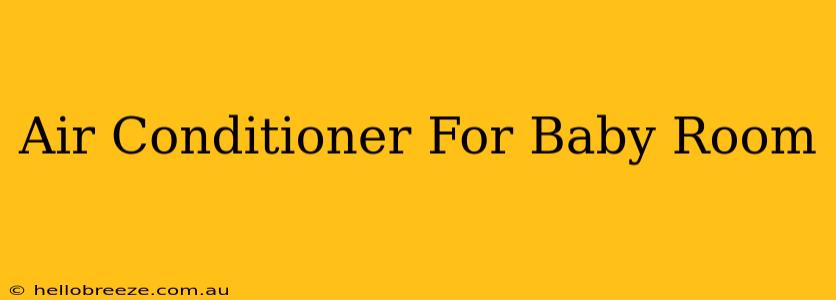Choosing the right air conditioner for your baby's room is crucial for ensuring a safe and comfortable sleep environment. A properly cooled room can significantly reduce the risk of SIDS (Sudden Infant Death Syndrome) and help your little one sleep soundly through the night. This guide will walk you through the essential factors to consider when selecting an air conditioner for your baby's nursery.
Factors to Consider When Choosing a Baby Room Air Conditioner
Several factors influence your choice of air conditioner for your baby's room. Prioritizing safety and energy efficiency is paramount.
1. Safety First: Preventing Accidents and Health Risks
- Placement: Ensure the air conditioner is securely mounted and out of your baby's reach. Avoid placing it directly above the crib to prevent potential falls or damage.
- Noise Level: Babies are sensitive to noise. Opt for a quieter model to avoid disturbing their sleep. Look for decibel ratings (dBA) – lower is better. A unit with a sleep mode is also beneficial.
- Air Quality: Consider air conditioners with HEPA filters to remove allergens and pollutants from the air, reducing the risk of respiratory issues.
- Window Unit vs. Portable: Window units are generally more energy-efficient but may not be suitable for all homes. Portable units offer flexibility but often consume more energy.
- Regular Maintenance: Regularly clean or replace air filters to maintain air quality and ensure the unit's efficiency.
2. Energy Efficiency: Saving Money and the Planet
- Energy Star Rating: Look for the Energy Star rating. This signifies that the unit meets strict energy efficiency guidelines, saving you money on electricity bills and reducing your environmental impact.
- SEER Rating: The Seasonal Energy Efficiency Ratio (SEER) indicates how efficiently the unit cools over an entire season. Higher SEER ratings mean better energy efficiency.
3. Size and Cooling Capacity: Perfect Climate Control
- Room Size: Measure your baby's room accurately to determine the appropriate BTU (British Thermal Unit) rating for the air conditioner. An undersized unit will struggle to cool the room effectively, while an oversized unit will cycle on and off frequently, leading to temperature fluctuations.
- BTU Calculation: Many online calculators can help you determine the right BTU based on your room's square footage, insulation, and climate.
4. Features to Look For: Added Convenience and Comfort
- Thermostat Control: Precise temperature control is essential. Look for units with adjustable thermostats that allow you to maintain a consistent and comfortable temperature in your baby's room.
- Remote Control: A remote control makes it easier to adjust the temperature and settings without disturbing your baby's sleep.
- Sleep Mode/Timer: A sleep mode often reduces noise and gradually adjusts the temperature during the night, promoting better sleep. A timer allows for scheduled operation.
Maintaining a Safe and Comfortable Room Temperature
While an air conditioner is crucial, it's equally important to maintain a safe and comfortable room temperature for your baby. The American Academy of Pediatrics recommends keeping your baby's room temperature between 68°F and 72°F (20°C and 22°C). Overcooling can be just as harmful as overheating. Always monitor the temperature regularly and adjust the air conditioner as needed.
Conclusion: Sweet Dreams for Baby
Choosing the right air conditioner for your baby's room requires careful consideration of safety, energy efficiency, and cooling capacity. By following these guidelines, you can create a safe, comfortable, and sleep-promoting environment for your little one. Remember to prioritize safety and always consult your pediatrician if you have any concerns. Sweet dreams to both you and your baby!

